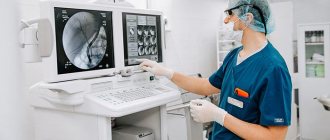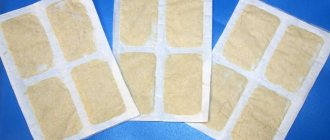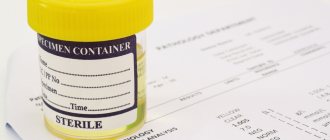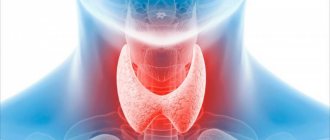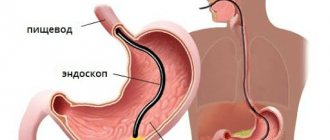Colonoscopy
– an endoscopic method for examining the inner surface of the intestine using a special device – a colonoscope. The flexibility and softness of the thin probe allows it to painlessly pass through all anatomical curves of organs, identifying various pathologies with high accuracy. The length of the device, equipped with a miniature video camera and lighting, is approximately 160 cm. The image is instantly transmitted to the monitor screen in multiple magnification. Thanks to this, the specialist can examine in detail the inner surface of the area under study, identify foci of inflammation and the nature of changes in the mucous membranes.
Indications for colonoscopy
Colonoscopy is prescribed in the following cases:
- frequent pain in the intestinal area
- bleeding
- purulent or mucous discharge from the rectal canal
- suspicion of inflammatory processes
- sudden, causeless weight loss
- the presence of cancer in the gastrointestinal tract in close relatives
- remove tumor or polyp
- remove foreign body
- stop the bleeding
- do a biopsy
- restore intestinal patency during narrowing (stenosis)
- eliminate adhesions
- identify the nature of hemorrhoids
Colonoscopy can be used to perform a number of medical procedures:
A referral for a colonoscopy is issued by a proctologist, gastroenterologist, or surgeon. The procedure itself is performed by an endoscopist. During the manipulation, he is assisted by a nurse and an anesthesiologist (if there is a need for general anesthesia).
Contraindications
Colonoscopy under anesthesia is not performed if the patient:
- chronic bronchitis or asthma;
- peritonitis;
- pregnancy;
- problems with blood clotting;
- colitis at a late stage;
- inflammatory and chronic diseases in the acute period.
Heart problems are not a contraindication for colonoscopy in general, but do not allow it to be performed under general anesthesia.
Preparing for a colonoscopy
An examination of the intestines requires careful preparation, so the decision on the need for it is made by the doctor based on a combination of clinical history and laboratory results, the current condition and age of the patient. If traditional colonoscopy is not possible, alternative methods are used.
The process of preparing for the procedure includes two stages - switching to a slag-free diet and cleansing the intestines. Three days before a colonoscopy, it is recommended to switch to a gentle diet, excluding fresh fruits and raw vegetables, cereals and pasta, brown bread, fried and smoked foods from the daily menu. It is advisable not to drink carbonated water, coffee and milk. They can cause severe fermentation in the intestines and bloating.
Allowed:
The next stage of preparation is intestinal cleansing.
For this purpose, special laxatives are used. The specialist prescribes a remedy suitable for each patient according to his individual indications.
Most used medications:
The mechanism of action of the drugs Fortrans and Endofalk is that they prevent the absorption of substances in the intestine. This leads to faster movement and evacuation of the contents (in the form of liquid stool) of the gastrointestinal tract. Due to the content of electrolyte salts in laxative preparations, disruption of the body's water-salt balance is prevented (dehydration does not occur, as with ordinary diarrhea).
The action of the drugs Fleet Phosphosoda and Lavacol is based on a delay in the excretion of water from the intestines, which causes an increase and softening of feces, increases peristalsis and leads to rapid emptying.
Another way to cleanse the body is a traditional enema. The procedure is carried out several times using 1.5 liters of clean water.
It is important to remember that on the eve of a colonoscopy, it is advisable to skip dinner, and on the morning of the procedure, you should not have breakfast.
Diet before colonoscopy
Before a colonoscopy you can eat:
- Boiled or steamed meat: chicken, fish, lean beef.
- Low-fat broth;
- Eggs;
- Boiled sausage;
- Cheese;
- Fermented milk products without additives (kefir, fermented baked milk);
- Unsweetened cookies;
- White bread.
Before a colonoscopy you should not eat:
- Legumes (beans, peas, soybeans, lentils);
- Vegetables (potatoes, cabbage, radishes, radishes, beets, carrots, turnips, garlic, onions);
- Sorrel and spinach;
- Fruits (apricots, plums, peaches, pears, dates, bananas, oranges, tangerines, raisins, grapes);
- Nuts and berries (currants, gooseberries, raspberries);
- Brown bread (including grain bread);
- Porridges made from pearl barley, millet, buckwheat and oatmeal.
Before a colonoscopy you should not drink:
- Milk;
- Alcohol;
- Carbonated drinks.
Performing a colonoscopy
Given the possible discomfort during manipulation, the procedure requires mandatory anesthesia. There are several options for pain relief during a colonoscopy. This is local anesthesia (treatment with ice-caine, luan gel, dicaine ointment, etc.), sedation (introduction to light medicated sleep) and general anesthesia. Local anesthesia is most often used. It allows you to communicate with the patient, thereby freely controlling the progress of the entire procedure.
A colonoscopy examination is carried out in a separate room at a medical institution. The patient changes into a special robe and lies on the couch on his side with his knees bent. After antiseptic treatment, the doctor carefully inserts a colonoscope into the anus, sequentially examining the intestinal walls. First, the area of the lower parts of the gastrointestinal tract is examined, then the condition of the sigmoid and cecum, as well as part of the small intestine, is assessed. A small amount of gas is injected to expand the lumen of the intestinal tube. In this case, the patient may be bothered by slight bloating. At the end of the examination, excess air is removed and the feeling of bloating disappears. A typical diagnostic procedure lasts approximately 15-20 minutes. If there is a need for urgent surgery, the time may be increased. After the colonoscopy is completed, the device is carefully removed from the intestine and sent for disinfection. The patient is advised to take a short rest and return home.
Types of anesthesia
In the standard version of the procedure, the probe itself is lubricated with an anesthetic. When it comes into contact with the intestinal walls, the medicine reaches them, is absorbed and reduces pain. However, if indicated or simply desired by the patient, anesthesia is used. It comes in two varieties:
- Medication sleep.
The safest way. The patient falls into a half-asleep, hears the doctor perfectly, retains the ability to follow his instructions, but experiences discomfort to a much lesser extent or does not experience it at all. The drugs are as modern as possible, the load on the body is small. - General anesthesia.
It puts a strain on the cardiovascular system, so it is not recommended for people with cardiovascular diseases and those who have recently suffered a stroke or heart attack. It has a negative effect on the lungs, so it is also not recommended for asthmatics and other patients. During general anesthesia, the patient is unconscious, does not experience any discomfort, and does not respond to any requests. After waking up, needs observation for at least 24 hours.
Before you determine which type is right for you, you will need to talk to an anesthesiologist and get tested.
When can I get my colonoscopy results?
A description of the intestinal condition can be obtained a couple of days after the procedure. If a biopsy was performed during colonoscopy, the time period increases until the histological examination data is obtained. In the conclusion, the compliance of the patient’s intestinal tube with certain criteria is indicated, as well as additional manipulations performed (if any). In addition to documents, you will be given a disc with a photograph or a reproduction of the colonoscopy process. Patients pass on the information received to the attending physician to determine further tactics for patient management.
FCC in ICLINIC: competent approach and modern technologies
ICLINIC Medical Center specializes in the prevention and diagnosis of cancer of the digestive system. Our diagnostic equipment is certified, has high grades and is additionally equipped with special software to increase the information content of studies. The colonoscopes used have a reduced tube diameter, high-precision cameras and monitors, and allow virtual chromoendoscopy of the smallest formations identified. All this ensures high diagnostic information content and reliability of the FCS.
The base price for video colonoscopy at ICLINIC in St. Petersburg is 5.5 thousand rubles. It may change during additional consultations with an anesthesiologist, endoscopist, leading specialist E.I. Levchenko, when using anesthesia of varying complexity, when taking a biopsy.
The affordable price of colonoscopy at our ICLINIC center in St. Petersburg is an opportunity to undergo a highly accurate examination of the large intestine using high-quality equipment and in comfortable conditions. Each patient receives a qualified written report drawn up in accordance with current clinical guidelines and protocols. The ICLINIC doctor also gives recommendations on the prevention and treatment of identified changes, and will suggest the optimal program for further examination.
To do a videocolonoscopy at ICLINIC, you can contact our administrators using the feedback form or by calling the phone numbers listed on the website.
Side effects of colonoscopy
Colonoscopy usually goes without consequences. Serious complications occur very rarely. Most often they are associated with the doctor’s lack of experience in performing such endoscopic manipulations. Possible risks include:
Who is it suitable for?
Colonoscopy under anesthesia is definitely performed if:
- Inflammatory processes occur in the intestines. Ulcers, colitis, enteritis are accompanied by pain; if the probe inaccurately touches the intestinal walls, this will cause too much discomfort to be ignored.
- The patient is less than twelve years old. It is difficult for the child to relax the muscles enough for the examination to be effective and produce results, in addition, pain during the process can be delayed and create unpleasant associations with hospitals in general.
- There are adhesions in the intestines formed by connective tissue. When air enters the intestine, this also provokes severe pain, which cannot be written off.
- The patient has a psychiatric diagnosis that will not allow him to sufficiently prepare, relax, and in some cases even understand what is happening.
- The patient has a low pain threshold and knows that the examination will be too unpleasant for him.
In a private clinic, a colonoscopy under anesthesia can be done simply at will, without indications.
Recovery after colonoscopy
Side effects of the procedure are discomfort as a result of the injection of air into the intestines during the examination, pain due to involuntary contractions of smooth muscles as the probe passes further than 15 centimeters. Proper rehabilitation will help the patient overcome all this - daily routine, dietary nutrition, medications that eliminate discomfort in the stomach and intestines.
The menu during this period is formed taking into account possible injury to the intestinal walls, especially if the examination was accompanied by the removal of tumors or the collection of biomaterial. Basic nutrition rules:
Among the permitted products: lean meats and fish, heat-treated vegetables, light broths, dairy products (low-fat cottage cheese, yogurt, kefir), lightly dried whole grain bread, eggs in the form of a steam omelet, savory cookies, fruit drinks, compotes, jelly. Method of preparation: boiling or stewing. It is advisable not to consume fresh fruits on the first day after a colonoscopy. It is forbidden to drink strong tea or coffee, carbonated drinks, alcohol, or freshly squeezed juices. Long-term dietary restrictions after colonoscopy are not required. 2-3 days are enough.
To reduce intestinal colic after the study, on the recommendation of a doctor, you can take sorbents and antispasmodics. To eliminate pain in the anus, it is advisable to use rectal suppositories or ointments that are used for hemorrhoids. If abdominal discomfort, diarrhea or constipation, bleeding from the anus and other disorders continue for more than 2-3 days, you should definitely consult a specialist! It is necessary to carefully monitor the condition of your body.
Colonoscopy
- a modern diagnostic method that will not only establish, but also eliminate the cause of pathological symptoms of the digestive tract. If you are regularly bothered by intestinal problems, do not delay visiting your doctor. Don't self-medicate!
Sign up for a colonoscopy procedure
Make an appointment
What can be revealed
FCS with anesthesia allows you to:
- carry out differential diagnosis between chronic diseases with colitis syndrome;
- identify diverticula;
- detect polyps and other benign neoplasms and remove them endoscopically;
- detect malignant tumors (cancer) of any form at the earliest stages, when they are still small in size and limited to the mucous membrane and submucosal layer.
At the moment, FCS is the most informative, reliable and safe way to assess the condition of the wall of the large intestine and identify any neoplasms located here.
SPECIAL CASES:
- If you have concomitant diseases, you should definitely consult your doctor.
- If you are taking any medications, be sure to tell your doctor before taking MOVIPREP®.
- Medicines taken orally within one hour before the onset of the laxative effect of the drug (for example, oral contraceptives) may be excreted from the gastrointestinal tract without being absorbed.
- Patients with cardiovascular diseases, increased body weight, and diabetes do not require dose adjustment.
RECOMMENDATIONS FOR TAKING MOVIPREP SOLUTION:
- From the moment you start taking MOVIPREP® you should not eat solid food. The prepared solution of MOVIPREP® does not replace regular fluid intake, therefore it is necessary to maintain a sufficient level of fluid in the body.
- The volume of water for preparing a solution of MOVIPREP® and additional approved liquid cannot be reduced.
- Take the drug solution in small doses, 250 ml every 15 minutes.
- While taking the drug solution, you need to observe physical activity: walk, perform circular movements of the body, bend to the sides, back and forth, squats.
- The onset of action of the drug varies individually: on average, the first stool appears within 1–2 hours from the start of administration.
- The effect of the drug continues individually: on average for 2 hours.
- By the time preparation is completed, the stool should change to a clear, colorless or slightly colored liquid, which indicates readiness for the procedure.
- No additional cleansing with enemas is required.
- When preparing for a colonoscopy, you should stop taking MOVIPREP® 2–4 hours before the procedure.
- When preparing at home, it is necessary to calculate the appropriate time interval for traveling to the clinic.
